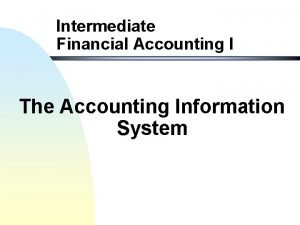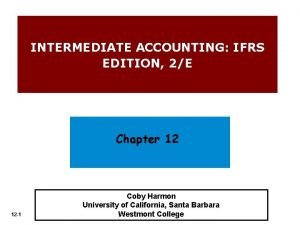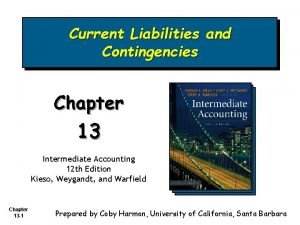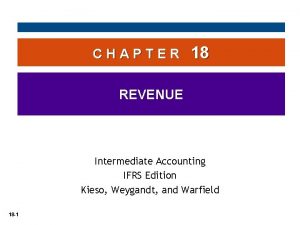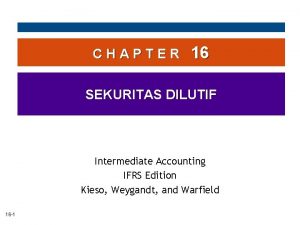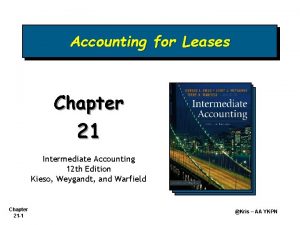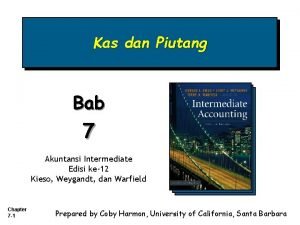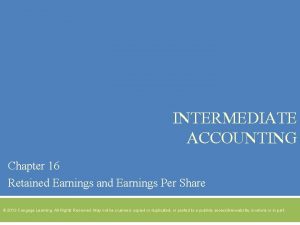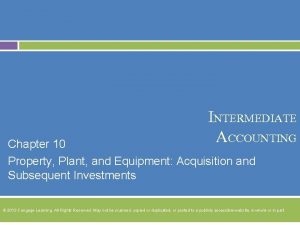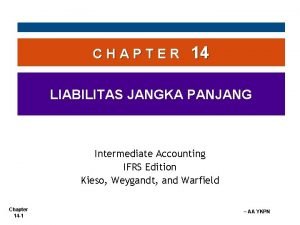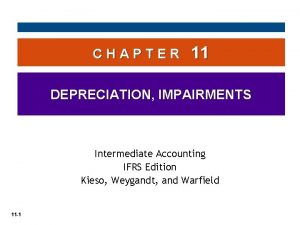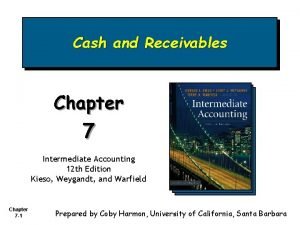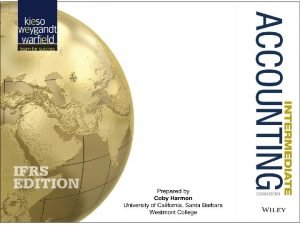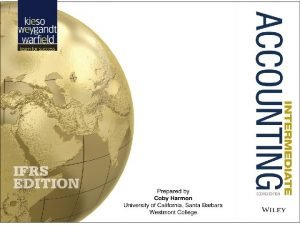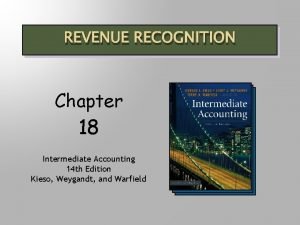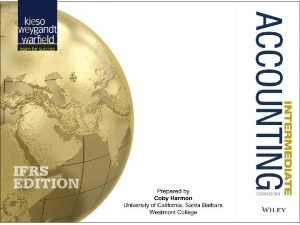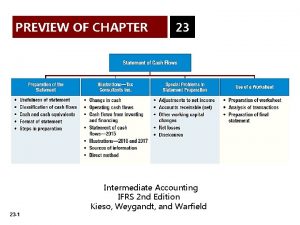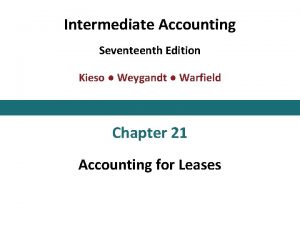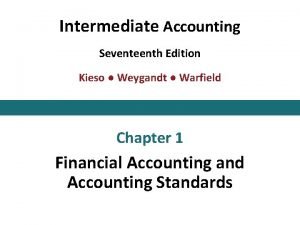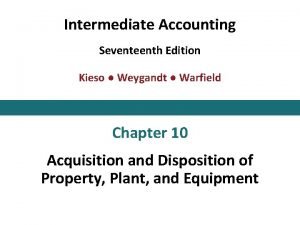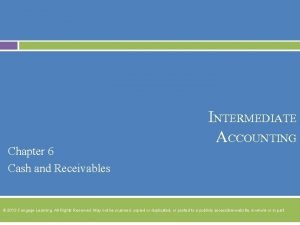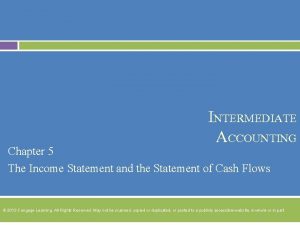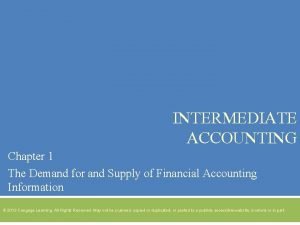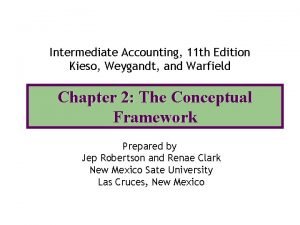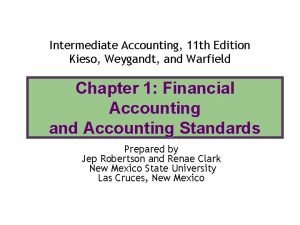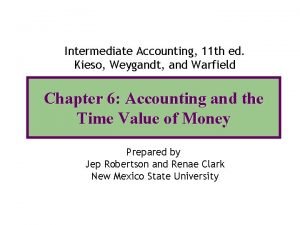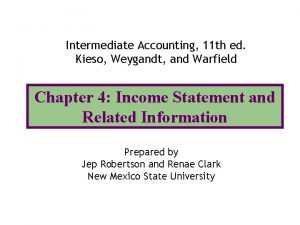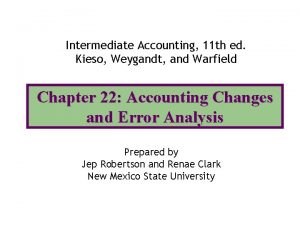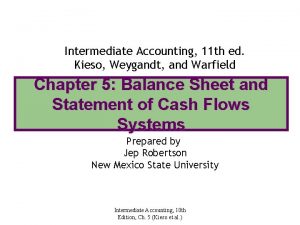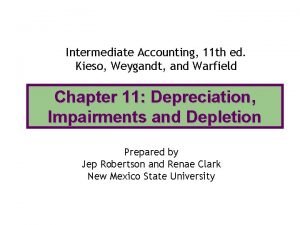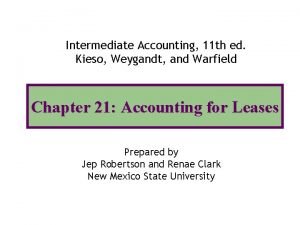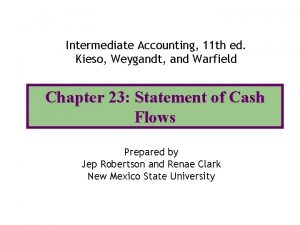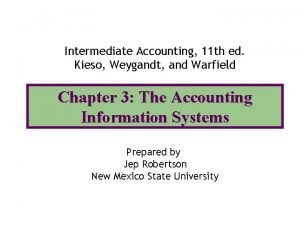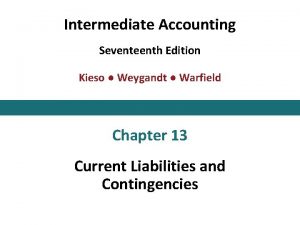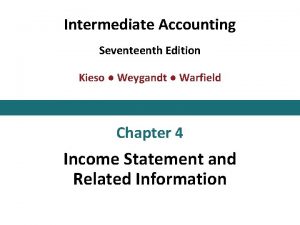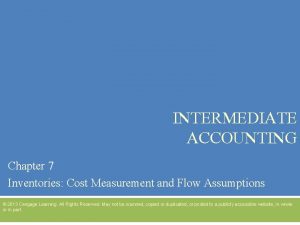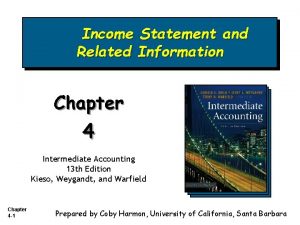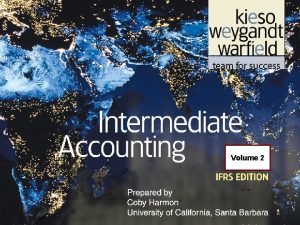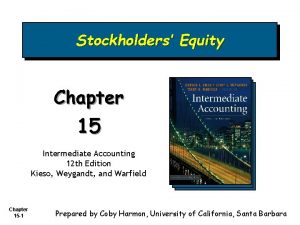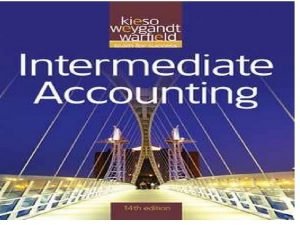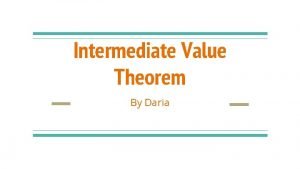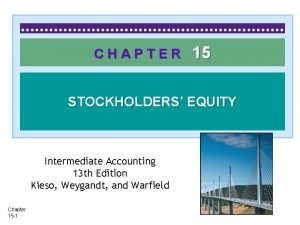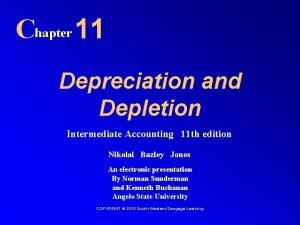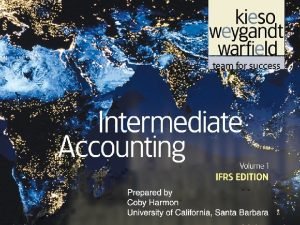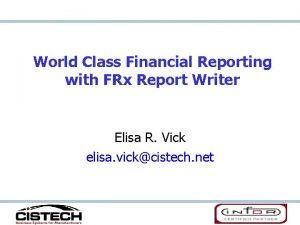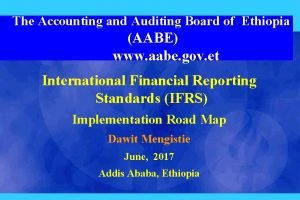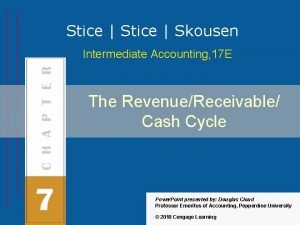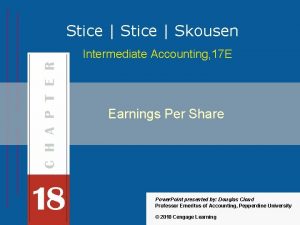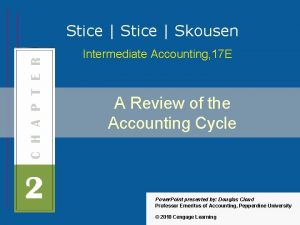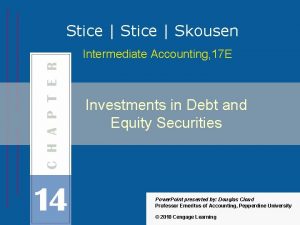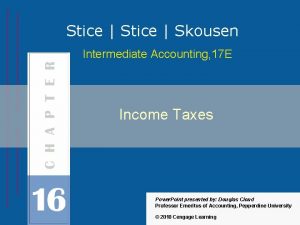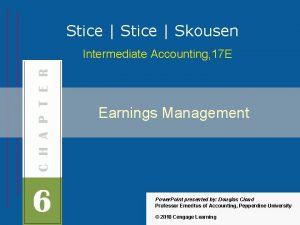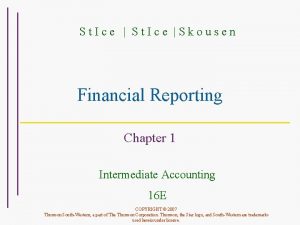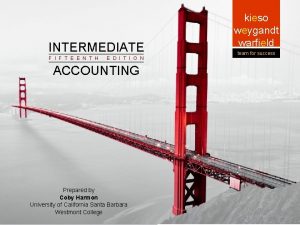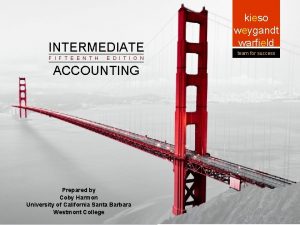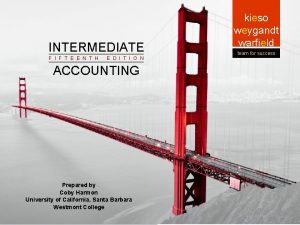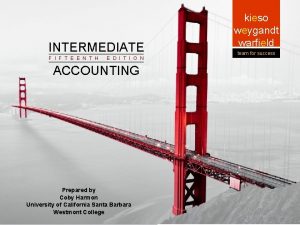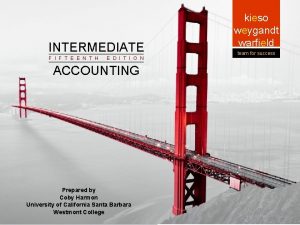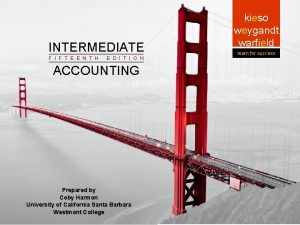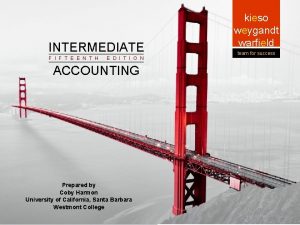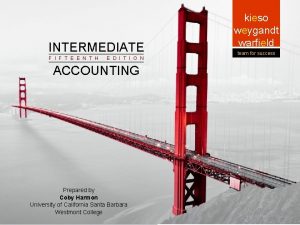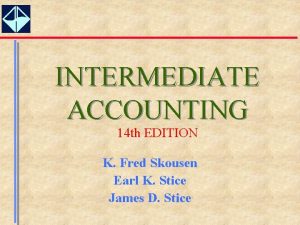Stice Skousen Intermediate Accounting 17 E Financial Reporting




























































- Slides: 60

Stice | Skousen Intermediate Accounting, 17 E Financial Reporting Power. Point presented by: Douglas Cloud Professor Emeritus of Accounting, Pepperdine University © 2010 Cengage Learning

Definition of Accounting “Accounting is a service activity. Its function is to provide quantitative information, primarily financial in nature, about economic entities that is intended to be useful in making economic decisions—in making reasoned choices among alternative courses of action. ” Statement of the Accounting Principles Board No. 4, par. 40. 2

Key Features of this Definition Accounting— • Provides a vital service in today’s business environment. • Is concerned primarily with quantitative financial information that is used in conjunction with qualitative evaluations in making judgments. • Information is used in making decisions about how to allocate scarce resources. • Information is intended to be useful in making economic decisions about the future. 3

Users of Accounting Information • Stakeholders are all parties interested in the financial health of a company. • Internal users make decisions that directly affect the internal operations of the enterprise. • External users make decisions concerning their relationship to the enterprise. 4

External Funding 1. Management accounting is concerned primarily with financial reporting for internal users, especially management. 2. Financial accounting focuses on the development and communication of financial information for external users. 5

Creditors need information about the profitability and stability of the company to decide whether to lend money to the company and, if so, what interest rate to charge. Investors (both existing stockholders and potential investors) need information concerning the safety and profitability of their investment. 6

Financial Reporting The balance sheet reports, as of a certain point in time, the resources of a company (the assets), the company’s obligations (the liabilities), and the equity of the owners. 7

Financial Reporting The income statement reports, for a certain interval, the net assets generated through business operations (revenues), the net assets consumed (the expenses), and the difference (net income). 8

Financial Reporting The statement of cash flows reports, for a certain interval, the amount of cash generated and consumed by a company through operating, financing, and investing activities. 9

Financial Reporting Accounting estimates and judgments are outlined in the notes to financial statements. 10

Auditor’s Role • Auditors, working independently of a company’s management and internal accountants, examine the financial statements. • They issue an auditor’s opinion about the fairness of the statements and their adherence to proper accounting principles. 11

Securities Exchange Commission (SEC) • 1929 stock market crash blamed on nonstandard accounting. • 1933 Securities Act established SEC to standardize accounting. • Created to protect the interests of investors by ensuring full and fair disclosure. • Granted legal authority to establishing GAAP. • Has tended to defer setting GAAP to the accounting profession. 12

Financial Accounting Standards Board (FASB) • The private-sector body responsible for the establishment of U. S. accounting standards (also known as GAAP). • Five full-time members are drawn from a variety of backgrounds—auditing, corporate accounting, financial services, and academia. • Members are required to sever all connections with their firms or institutions prior to assuming membership on the Board. • Appointment of new members is done by the Financial Accounting Foundation (FAF). 13

Governmental Accounting Standards Board (GASB) The FAF is also responsible for selecting and supporting members of GASB. The GASB was established in 1984 and sets financial accounting standards for state and local government entities. 14

The Standard-Setting Process • The major functions of the FASB are to study accounting issues and to establish accounting standards. • These standards are published as Statements of Financial Accounting Standards. • The FASB has also issued Statements of Financial Accounting Concepts that provide a framework within which specific accounting standards can be developed. 15

FASB “Due Process” 1. 2. 3. 4. 5. FASB staff assembles background information. The Board holds public meetings before a decision is made to add a project to the FASB’s formal agenda. After more study and further hearings, the Board often issues a report summarizing its Preliminary Views. Interested parties are invited to comment either in writing or orally at a public hearing. After comments from interested parties have been evaluated, the Board meets as many times as necessary to resolves the issues. (continues) 16

FASB “Due Process” 6. 7. 8. From these meetings, the Board developes an Exposure Draft of a statement that includes specific recommendations for financial and accounting reporting. At the end of the exposure period, 30 days or longer, all comments are viewed by the staff and the Board. Further deliberation by the Board leads to either the issuance of a Statement of Financial Accounting Standards (if at least three of the members approve), a revised Exposure Draft, or abandonment of the project. 17

Emerging Issue Task Force In an effort to overcome the methodical, sometimes slow, nature of the standard setting process, in 1984 the FASB established the Emerging Issues Task Force (EITF). The EITF assists the FASB in the early identification of emerging issues that affect financial reporting. 18

Securities and Exchange Commission (SEC) • Created by an act of Congress in 1934. • Primary role is to regulate the issuance and trading of securities by corporations to the general public. • Requires companies to furnish various financial statements and to have their external financial statements audited by independent accountants. (continues) 19

Securities and Exchange Commission (SEC) • It is vitally interested in financial reporting and the development of accounting standards. • It brings to the Board’s attention emerging problems that need to be addressed and sends observers to meet with the EITF. • It occasionally issues Staff Accounting Bulletins (SABs), which are SEC staff interpretations. 20

American Institute of Certified Public Accountants (AICPA) • It is the professional organization of practicing certified public accountants (CPAs) in the United States. • It is responsible for preparing and grading the Uniform CPA Examination. (continues) 21

American Institute of Certified Public Accountants (AICPA) • It is concerned with maintaining the integrity of the profession through its Code of Professional Conduct and through a quality control program, which includes a process of peer review of CPA firms conducted by other CPAs. 22

American Accounting Association (AAA) • The AAA is an organization of accounting professors. • It sponsors national and regional meetings where accounting professors discuss technical research and share teaching techniques and materials. • It organizes working committees of professors to study and comment on accounting standards issues. (continues) 23

American Accounting Association (AAA) • The AAA publishes a number of academic journals, including The Accounting Review and Accounting Horizons. • It motivates and facilitates curriculum revision to keep pace with the changes in the accounting profession. 24

Internal Revenue Service (IRS) • The IRS has the primary goal of equitably collecting revenue. • Although not the same, there are many areas where tax and financial accounting are closely related. 25

What is GAAP? (continues) 26

What is GAAP? 27

International Accounting Standards Board (IASB) • Formed in 1973 to develop worldwide accounting standards. • Similar to FASB, IASB develops proposals, circulates these among interested organizations, receives feedback, and then issues a final pronouncement. • Board members are representatives from the United States, the United Kingdom, France, Sweden, China, Australia, South Africa, and Japan. (continues) 28

International Accounting Standards Board (IASB) • Accounting standards issued by the IASB are referred to as International Financial Reporting Standards (IFRSs) if issued since to 2001 and International Accounting Standards (IASs) if issued prior to 2001. 29

Conceptual Framework • A strong theoretical foundation is essential if accounting practice is to keep pace with a changing business environment. • The conceptual framework plays a vital role in the development of new standards and in the revision of previously issued standards. • A conceptual framework provides a guide for future practice. 30

Concepts Statements • In 2000, FASB issued seven Statements of Financial Accounting Concepts, which addressed four major areas: 1. Objectives: What are the purposes of financial reporting? 2. Qualitative characteristics: What are the qualities of useful financial information? 3. Elements: What is an asset? a liability? a revenue? an expense? 4. Recognition, measurement, and reporting: How should the objectives, qualities and elements definitions be implemented? 31

Objectives of Financial Reporting Usefulness Financial reporting should provide information that is useful to present and potential investors and creditors and other users in making rational investment, credit, and similar decisions. Statement of Financial Accounting Concepts No. 1, par. 34. 32

Objectives of Financial Reporting Understandability Financial reporting should provide information that is understandable to one who has a reasonable knowledge of accounting and business and who is willing to study and analyze the information presented. Statement of Financial Accounting Concepts No. 1, par. 34. 33

Objectives of Financial Reporting Target Audience: Investors and Creditors While there are many potential users of financial reports, the objectives are directed primarily toward investors and creditors. 34

Objectives of Financial Reporting Assessing Future Cash Flows Financial reporting should provide information that is useful in assessing amounts, timing, and uncertainty (risk) of prospective cash flows. 35

Objectives of Financial Reporting Evaluating Economic Resources Financial reporting should also provide information about a company’s assets, liabilities, and owners’ equity to help investors, creditors, and others evaluate the financial strengths and weaknesses of the enterprise and its liquidity and solvency. 36

Objectives of Financial Reporting Primary Focus on Earnings Information about company earnings, measured by accrual accounting, generally provides a better basis forecasting future performance than does information about current cash receipts and disbursements. 37

Qualitative Characteristics of Accounting Information Benefits Greater Than Costs The information must be worth more than the cost of producing it. 38

Qualitative Characteristics of Accounting Information Relevance The information must “make a difference. ” It must carry the qualities of: • Feedback value • Predictive value • Timeliness 39

Qualitative Characteristics of Accounting Information Relevance Relevant information normally provides both feedback value and predictive value at the same time. 40

Qualitative Characteristics of Accounting Information Relevance Timeliness is essential for information to “make a difference” because if the information becomes available after the decision is made, it isn’t of much use. 41

Qualitative Characteristics of Accounting Information Reliability The information must be relatively free from error and represent what it claims to represent. It must have: • Verifiability • Representational faithfulness • Neutrality 42

Qualitative Characteristics of Accounting Information Reliability Verifiability implies consensus. Representational faithfulness means that there is agreement between a measurement and the economic activity or item that is being measured. Neutrality is similar to the concept of fairness. 43

Qualitative Characteristics of Accounting Information Comparability The information must be relatable to a benchmark or standard. The comparison may be with data for other firms or it may be with similar information for the same firm but for other periods of time. 44

Qualitative Characteristics of Accounting Information Materiality Is the item large enough to influence the decision of a user of information? Quantitative guidance concerning materiality is lacking, so managers and accountants must exercise judgment in determining whether an item is material. 45

Qualitative Characteristics of Accounting Information Conservatism The concept of conservatism can be summarized as follows: When in doubt, recognize all losses but don’t recognize any gains. 46

Recognition • Recognition—Taking all the estimates and judgments into one number and using that number to make a journal entry. • Recognition Criteria—For an item to be formally recognized, it must meet one of the definitions of the elements of the financial statements. – For example, revenue must meet the definition of revenue to be recorded and reported on the income statement. • Disclosure—Skipping the journal entry and just relying on the note to convey the information to users. 47

Measurement Five measurement attributes are: 1. Historical cost 2. Current replacement cost 3. Fair value 4. Net realizable value 5. Present (or discounted) value 48

Reporting Included in the recommended set of general-purpose financial statements are reports that show the following: • Financial position at the end of the period • Earnings (net income) for the period • Cash flows during the period • Investments by and distributions to owners during the period • Comprehensive income for the period 49

Reporting Comprehensive income differs from earnings in that it includes unrealized gains and losses not recognized in the income statement. 50

Full Disclosure Principle For financial statements to be most effective, all relevant information should be presented in an unbiased, understandable, and timely manner. This is sometimes referred to as the full disclosure principle. 51

Traditional Assumptions The FASB conceptual framework is influenced by five basic assumptions. 1. Economic entity 2. Going concern 3. Arm’s-length transactions 4. Stable monetary unit 5. Accounting period 52

Traditional Assumptions of the Accounting Model Economic Entity The business enterprise is viewed as a specific economic entity separate and distinct from its owners and any other business unit. 53

Traditional Assumptions of the Accounting Model Going Concern In the absence of evidence to the contrary, the entity is viewed as a going concern. In other words, it is assumed that the enterprise will last indefinitely. 54

Traditional Assumptions of the Accounting Model Arm’s-Length Transactions are assumed to occur between independent parties, each of which is capable of protecting its own interests. 55

Traditional Assumptions of the Accounting Model Stable Monetary Unit The stable monetary unit assumption allows for the ignoring of changes in the dollar’s purchasing power resulting from inflation. 56

Traditional Assumptions of the Accounting Model Accounting Period Because accounting information is needed on a timely basis, the life of a business is divided into specific accounting periods, usually one year. 57

Careers in Financial Accounting Public Accounting Pubic accountants do not work for a single business enterprise. Rather, they provide a variety of services for many different individuals and business clients. 58

Careers in Financial Accounting Corporate Accounting A large business enterprise employs financial accountants who are primarily concerned with external financial reporting, management accountants who are primarily concerned with internal financial reporting, and tax accountants. 59

Careers in Financial Accounting User (Analyst, Banker, Consultant) Many students take accounting in preparation for becoming a user of financial statements. Credit analysts, investment bankers, brokers, and business consultants need a strong working knowledge of accounting as well as strong skills in information technology. 60
 Accounts payable subsidiary ledger
Accounts payable subsidiary ledger Drawback of financial accounting
Drawback of financial accounting Financial accounting and accounting standards chapter 1
Financial accounting and accounting standards chapter 1 Role and responsibility of management accountant ppt
Role and responsibility of management accountant ppt Chapter 15 intermediate accounting
Chapter 15 intermediate accounting Intermediate accounting kieso chapter 17 investment
Intermediate accounting kieso chapter 17 investment Amortization expense formula
Amortization expense formula Accounting for current liabilities and contingencies
Accounting for current liabilities and contingencies Intermediate accounting leases
Intermediate accounting leases Chapter 18 revenue recognition intermediate accounting
Chapter 18 revenue recognition intermediate accounting Chapter 16 kieso
Chapter 16 kieso Types of leases
Types of leases Chapter 21 accounting for leases kieso terjemahan
Chapter 21 accounting for leases kieso terjemahan Chapter 19 accounting for income taxes
Chapter 19 accounting for income taxes Bab 7 kas dan piutang
Bab 7 kas dan piutang Intermediate accounting
Intermediate accounting Intermediate accounting chapter 16
Intermediate accounting chapter 16 Intermediate accounting chapter 10
Intermediate accounting chapter 10 Chapter 2 conceptual framework
Chapter 2 conceptual framework Intermediate accounting chapter 14
Intermediate accounting chapter 14 Chapter 11 intermediate accounting
Chapter 11 intermediate accounting Cash and receivables intermediate accounting
Cash and receivables intermediate accounting Chapter 3 intermediate accounting
Chapter 3 intermediate accounting Chapter 15 intermediate accounting
Chapter 15 intermediate accounting Chapter 18 revenue recognition
Chapter 18 revenue recognition Liablities
Liablities Conceptual framework of iasb and fasb
Conceptual framework of iasb and fasb Intermediate accounting chapter 9
Intermediate accounting chapter 9 Intermediate accounting chapter 23
Intermediate accounting chapter 23 Intermediate accounting
Intermediate accounting Accounting principles
Accounting principles Commercial substance
Commercial substance Cash and receivables intermediate accounting
Cash and receivables intermediate accounting Income statement intermediate accounting
Income statement intermediate accounting Intermediate accounting chapter 1
Intermediate accounting chapter 1 Intermediate accounting kieso
Intermediate accounting kieso Intermediate accounting
Intermediate accounting Intermediate accounting kieso
Intermediate accounting kieso Intermediate accounting kieso
Intermediate accounting kieso Intermediate accounting kieso
Intermediate accounting kieso Intermediate accounting kieso
Intermediate accounting kieso Intermediate accounting kieso
Intermediate accounting kieso Capital lease 4 criteria
Capital lease 4 criteria Intermediate accounting kieso
Intermediate accounting kieso Intermediate accounting kieso
Intermediate accounting kieso Equity adalah
Equity adalah Warranty journal entries
Warranty journal entries Intermediate accounting
Intermediate accounting Dollar value lifo
Dollar value lifo Chapter 4 income statement and related information
Chapter 4 income statement and related information Intermediate accounting chapter 1
Intermediate accounting chapter 1 Intermediate accounting chapter 17 investments test bank
Intermediate accounting chapter 17 investments test bank Chapter 15 intermediate accounting
Chapter 15 intermediate accounting Revenue recognition intermediate accounting
Revenue recognition intermediate accounting Khan academy intermediate value theorem
Khan academy intermediate value theorem Chapter 15 stockholders equity
Chapter 15 stockholders equity Chapter 11 depreciation
Chapter 11 depreciation Chapter 12 intangible assets
Chapter 12 intangible assets Frx report wizard
Frx report wizard Accounting and auditing board of ethiopia
Accounting and auditing board of ethiopia The purpose of financial statement
The purpose of financial statement
